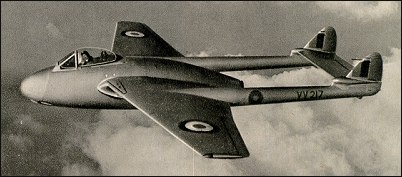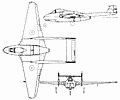 |
De Havilland D.H.100 Vampire1943 |  |
| FIGHTER | Virtual Aircraft Museum / United Kingdom / De Havilland |
 |
Perhaps one of the most interesting features of the de Havilland Vampire (as it became known) was the fact that its design began in 1941, not long after the first flight of the first prototype Mosquito. Designed to satisfy Air Ministry Specification E.6/41 for an interceptor fighter to be powered by the then-developing turbojet engine, the twin-boom configuration of this aircraft was virtually dictated by the chosen power plant. This was because a single turbojet was to provide the total thrust; as this was very limited in early engines, it was necessary to ensure that power loss from the jet tailpipe was restricted to an absolute minimum by keeping the tailpipe as short as possible. Borrowed from the Mosquito for the cockpit/ engine nacelle structure was the plywood-balsa-plywood sandwich form of construction. Like the Mosquito's fuselage, this was built in two half-shells which were joined top and bottom. The monoplane wing was an all-metal structure, incorporating the engine air intakes in the wing roots, split trailing-edge flaps, air brakes and ailerons. The pilot, seated well forward in the central nacelle beneath a three-piece canopy (replaced later by a bubble canopy), had a superb field of view. Powered by a 12kN de Havilland Goblin turbojet, the prototype Vampire flew for the first time on 20 September 1943. The first production F.1 Vampire made its first flight on 20 April 1945 powered by the same engine as the prototype, as were the next 39 aircraft. Subsequent F.1 had 13.8kN Goblin Gn.2 engines. Entering service too late to make a contribution to World War II, Vampires began to equip RAF squadrons in mid-1946 and were the second type of jet fighter supplied to it. Subsequent variants included the F.3 with increased internal fuel capacity and provisions for auxiliary tanks: six of these fighters were the first RAF jet-powered aircraft to achieve a flight across the North Atlantic. The FB.5 close-support fighter/bomber was introduced in 1949 with reduced wing span and long-stroke landing gear to cater for higher landing weights. FB.9 with more power and improved equipment for operation in tropical conditions entered service with the Far East and Middle East Air Forces in 1952; these were the last RAF single-seat variants. A total of 95 two-seat NF.10 Vampire night-fighters also served in an interim capacity with the RAF from 1951, pending the introduction of Meteor and Venom night fighters. The last major variant was the Vampire T.11 two-seat trainer, over 800 of which were built. The Royal Navy had a small number of F.20 Sea Vampires, generally similar to the RAF's FB.5, and 74 T.22 two-seat trainers derived from the T.11.
|  COMPANY PROFILE | ||||||||||||||||||||||||||||||||||||||||||||||||||||||
 |

|

